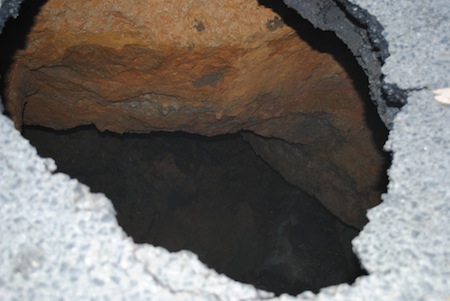It is no secret that our nation's infrastructure is under stress. Bridges are aging, our roads are littered with potholes, the quality of our rail system is decades behind nations like Japan and France, and if you have ever traveled overseas, you will notice how dilapidated our airports have become in comparison to other developed countries. On my recent honeymoon in South Africa, I remarked to my wife that the airports in both Johannesburg and Cape Town are much more modern and able to handle growing passenger traffic than any domestic airport I have visited.
Here in D.C., the infrastructure is literally crumbling beneath our feet. On November 3, 2011, a large hole opened up on a section of roadway in Adams Morgan, on Champlain Street NW at the corner of Kalorama Road NW. As a vehicle turned the corner, the hole appeared suddenly, stranding up the vehicle. While the opening did not appear to be massive, just slightly larger than a car tire, a greater problem was discovered when D.C. Water (where I serve as a board member) did some investigating. An undetected sewer failure caused massive erosion in the ground beneath Adams Morgan.

Photo courtesy D.C. Water
According to D.C. Water General Manager, George Hawkins, the three-foot by five-foot sewer built out of brick in 1889, "had completely disintegrated, leaving what looked like an underground stream." What was a small surface breach on the street could easily have been a large sinkhole. It seems a miracle that nobody was hurt and that the disruption was not more serious. Given that many of our sewer systems were built more than 120 years ago, who knows where the next street collapse is lurking?
Our aging Metro system is another cause for concern. The Washington Metropolitan Area Transit Authority (WMATA) is investing $5 billion to upgrade the entire system. This includes fixing tracks, escalators, stations and purchasing modern railcars. Despite all of this investment, the system is running chronic deficits and users are forced to choose between service reductions and rate increases. As too many Americans see their incomes stagnate or become reduced, and as the population increases, neither option seems acceptable.
Infrastructure is not just about aesthetics. It's about economic growth and about ensuring that people and goods can be transported safely and efficiently. Companies want to operate in environments that are predictable; and right now crumbling roads and bridges, clogged transit hubs, and the unknown state of our water system does not instill confidence in those looking to do business in our region. If employees can't come to work on time because of road closures and transit delays, the result promises to be lost productivity and lost income for everyone.
The infrastructure problems in Washington, D.C., are similar to those in cities and towns around the country. These are serious challenges that local governments cannot handle on their own, nor should they. They are national, impacting communities everywhere, and the federal government needs to take a leadership role. Policymakers must realize that they are sacrificing repair of a crumbling infrastructure (among many other serious problems to our society) when they refuse to consider increasing taxes on millionaires or to make sensible cuts to defense and entitlement programs.
Addressing our critical infrastructure needs does not favor the working class, middle class, or upper class. The 99% and the one percent all benefit from safe and dependable roads, bridges, transit systems and utilities. We are running large federal, state and local deficits, and finding money for these projects is difficult. However, adequate investment now will create jobs now and enhance our economic competitiveness for years to come.